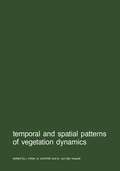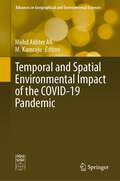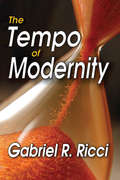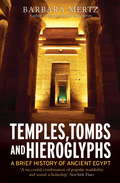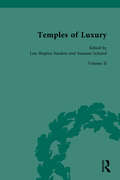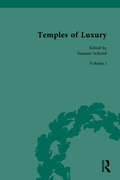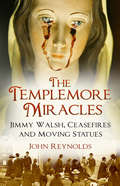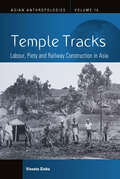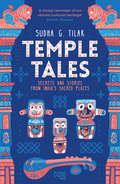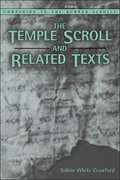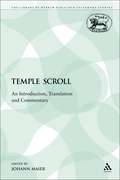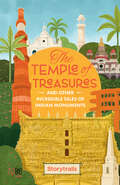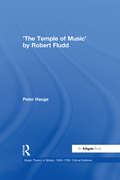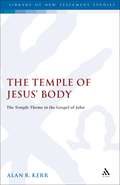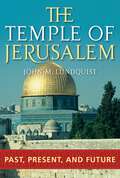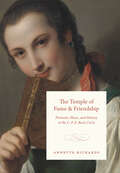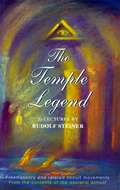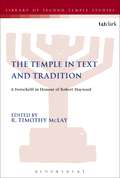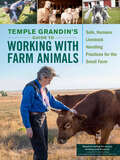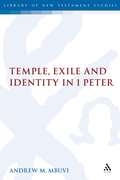- Table View
- List View
Temporal and spatial patterns of vegetation dynamics (Advances in Vegetation Science #9)
by J. Miles W. Schmidt E. Van Der MaarelTemporal and Spatial Environmental Impact of the COVID-19 Pandemic (Advances in Geographical and Environmental Sciences)
by Mohd Akhter Ali M. KamrajuThis book identifies, evaluates and reports the impacts of the COVID-19 pandemic on the physical, biological and socioeconomic environment, using the science and technology of geoinformatics. It encourages the environmental considerations in the future city and policy planning and decision-making. For example, according to the World Health Organization, 80% of people living in cities are exposed to polluted air that exceeds healthy levels. City planners have applied the developing concepts of sustainability to modern debates over how cities and regions should be reviewed, regenerated and reformed since the introduction of the concept in developmental science. During the COVID-19 pandemic, a remarkable drop in air pollution has been observed in India and other countries, which has accelerated the shift to green and sustainable development. Geoinformatics can provide solutions and resources for local, sustainable activities in education, health, sustainable agriculture, resource management and related fields. This book serves researchers in a variety of areas, including hazards, land surveys, remote sensing, cartography, geophysics, geology, natural resources, environment and geography.
The Tempo of Modernity
by Gabriel R. RicciThe present work is a study in the history of an enduring idea that defines the inner life of the mind and also supplied a substratum for the twentieth-century literary imagination and substance for philosophical thinking, producing a unique alliance between philosophy and literature. This special union was forged by a new holistic conception of time which supplemented, and even supplanted, the conventional sense of chronological time. This temporal turn animated the existential insights of Husserl, Heidegger, and Bergson, but it was grounded in nineteenth-century advances in the biological sciences, the hegemony of Hegelianism, and even stretched back to Augustine's early meditation on time in Book XI of his Confessions. In linking together a set of thinkers who addressed this form of temporal consciousness, Gabriel R. Ricci illuminates a common intellectual preoccupation from the vantage point of a concept. The authors do not together assemble the thought; it is the thought that produced a collective voice. This voice appears in the episodes outlined in each chapter, and they are framed by an introduction, which explores Joseph Frank's insights into the new spatial forms in literature, and an epilogue, which resurrects J.W. Dunne's peculiar dream experiments and theory of precognition. Ricci employs Frank's seminal essay to draw comparisons between literature's adaptation of the new time sense and philosophy's expression of the new compatibility between space and time. Dunne's theory serves to demonstrate the continuity between literary form and philosophical speculation.
The Tempo of Modernity
by Gabriel R. RicciThe present work is a study in the history of an enduring idea that defines the inner life of the mind and also supplied a substratum for the twentieth-century literary imagination and substance for philosophical thinking, producing a unique alliance between philosophy and literature. This special union was forged by a new holistic conception of time which supplemented, and even supplanted, the conventional sense of chronological time. This temporal turn animated the existential insights of Husserl, Heidegger, and Bergson, but it was grounded in nineteenth-century advances in the biological sciences, the hegemony of Hegelianism, and even stretched back to Augustine's early meditation on time in Book XI of his Confessions. In linking together a set of thinkers who addressed this form of temporal consciousness, Gabriel R. Ricci illuminates a common intellectual preoccupation from the vantage point of a concept. The authors do not together assemble the thought; it is the thought that produced a collective voice. This voice appears in the episodes outlined in each chapter, and they are framed by an introduction, which explores Joseph Frank's insights into the new spatial forms in literature, and an epilogue, which resurrects J.W. Dunne's peculiar dream experiments and theory of precognition. Ricci employs Frank's seminal essay to draw comparisons between literature's adaptation of the new time sense and philosophy's expression of the new compatibility between space and time. Dunne's theory serves to demonstrate the continuity between literary form and philosophical speculation.
Temples, Tombs and Hieroglyphs, A Brief History of Ancient Egypt: A Brief History Of Ancient Egypt (Brief Histories)
by Barbara MertzHave you ever wondered what it was like in the Valley of the Kings? To unlock the mysteries of the pyramids? Or sail down the Nile on Cleopatra's Barge? In her fascinating new introduction to the wonders of ancient Egypt expert Barbara Mertz tells the extraordinary history from the first stone age settlements to the age of Cleopatra and the Roman Emperors. It offers not just insights into the glories of the Pharaohs, but also intriguing glimpses of everyday life, folklore and culture.
Temples of Luxury: Volume II: Department Stores
by Lise Shapiro Sanders Susanne SchmidThis two-volume collection of British primary sources examines institutions such as hotels, inns, arcades, bazaars, co-operatives, shops and department stores in the long nineteenth century, which were often coded as ‘luxurious’. This period was marked not only by an increase of individual consumerism but also by the institutionalisation of opulent, often purpose-built spaces such as the much-admired new grand hotels, supposedly an American invention, and department stores, modelled on the French grands magasins. These environments were tied to leisure (no longer a prerogative of the upper classes) and thus to modernity. In addition to addressing the luxurious side of these institutions, including architectural innovation and interior decoration, we also consider the other side of luxury, examining the experience of staff and period debates over the morality of consumption. This edition seeks to explore a fascinating but hitherto often neglected side of the British nineteenth century by bringing together a collection of annotated primary texts and visual material documenting these ‘temples of luxury’ as they were seen by their contemporaries.
Temples of Luxury: Volume I: Hotels
by Susanne SchmidThis volume examines hotels, inns, restaurants, and travelling on luxurious trains and ships. The volume also explores social rituals, consumer culture, and issues of class and gender as well as the institutions of travelling for health, education, or any other purpose.
Temples of Luxury: Volume I: Hotels
This volume examines hotels, inns, restaurants, and travelling on luxurious trains and ships. The volume also explores social rituals, consumer culture, and issues of class and gender as well as the institutions of travelling for health, education, or any other purpose.
Temples of Luxury: Volume II: Department Stores
This two-volume collection of British primary sources examines institutions such as hotels, inns, arcades, bazaars, co-operatives, shops and department stores in the long nineteenth century, which were often coded as ‘luxurious’. This period was marked not only by an increase of individual consumerism but also by the institutionalisation of opulent, often purpose-built spaces such as the much-admired new grand hotels, supposedly an American invention, and department stores, modelled on the French grands magasins. These environments were tied to leisure (no longer a prerogative of the upper classes) and thus to modernity. In addition to addressing the luxurious side of these institutions, including architectural innovation and interior decoration, we also consider the other side of luxury, examining the experience of staff and period debates over the morality of consumption. This edition seeks to explore a fascinating but hitherto often neglected side of the British nineteenth century by bringing together a collection of annotated primary texts and visual material documenting these ‘temples of luxury’ as they were seen by their contemporaries.
The Templemore Miracles: Jimmy Walsh, Ceasefires and Moving Statues
by John ReynoldsIN the aftermath of the 1916 Rising, the ensuing guerrilla war reached its peak in August 1920, in the garrison town of Templemore, when a series of extraordinary events occurred. 16-year-old farm labourer Jimmy Walsh claimed that he was experiencing Marian apparitions, and that religious statues owned by him were moving and bleeding. Miraculous cures were claimed and the religious fervour that gripped Ireland led to an influx of thousands of pilgrims. The phenomenon of the ‘Templemore miracles’ or ‘bleeding statues’ lasted for several weeks and an informal ceasefire arose while the rebels, the police, military and civilian population struggled to comprehend the surreal situation. With the logistics of conducting the war disrupted by the flood of pilgrims, the IRA stepped in. They interrogated Walsh and, with the direct involvement of Michael Collins, planned to deter further pilgrimages to Templemore. In due course, Walsh had left Ireland, never to return, and the war resumed with an even greater degree of ferocity. Here, John Reynolds charts the bizarre goings-on that intersected the spiritual, social and martial fixations of early twentieth-century Ireland based around a small town and a boy with visions.
Temple Tracks: Labour, Piety and Railway Construction in Asia (Asian Anthropologies #16)
by Vineeta SinhaThe notions of labour, mobility and piety have a complex and intertwined relationship. Using ethnographic methods and a historical perspective, Temple Tracks critically outlines the interlink of railway construction in colonial and post-colonial Asia, as well as the anthropology of infrastructure and transnational mobilities with religion. In Malaysia and Singapore, evidence of religion-making and railway-building from a colonial past is visible in multiple modes and media as memories, recollections and ‘traces’.
Temple Tracks: Labour, Piety and Railway Construction in Asia (Asian Anthropologies #16)
by Vineeta SinhaThe notions of labour, mobility and piety have a complex and intertwined relationship. Using ethnographic methods and a historical perspective, Temple Tracks critically outlines the interlink of railway construction in colonial and post-colonial Asia, as well as the anthropology of infrastructure and transnational mobilities with religion. In Malaysia and Singapore, evidence of religion-making and railway-building from a colonial past is visible in multiple modes and media as memories, recollections and ‘traces’.
Temple Tales: Secrets and Stories from India's Sacred Places
by Sudha G. TilakWhich holy place in India has the mysteries of the universe hidden away in an icy cave? Where would you find a shrine for a goddess of veggies? At which deity’s temple is the daily offering a tonic, of all things? This delightful and enchanting book opens the doors to the secrets and surprises hidden in temples across the country. These unique temples are not just places of worship, but living museums of architectural wonders, mind-boggling sculptures, graceful dances, colourful crafts and many other cultural activities. More than anything, they are treasure troves of lore and legend, teeming with tales of gods and goddesses, demons and devotees, plants and beasts, the magical and the mysterious – all just waiting to be discovered by you. Join Sudha G. Tilak as she takes you on an unusual journey to the country’s most sacred places, where the lines between fact and faith are blurred and stories come alive!
Temple Scroll and Related Texts (Companion to the Qumran Scrolls)
by Sidnie White CrawfordThe Temple Scroll and Related Texts, one of the series Companion to the Qumran Scrolls, is a comprehensive roadmap to the Temple Scroll, the longest and one of the most complex of the manuscripts from Qumran. The central chapter contains a discussion of the contents of the Temple Scroll, including sections on the Temple and its courts, purity regulation, the festival calendar, and the Deuteronomic Paraphrase with the Law of the King. The Companion also includes a chapter on the Description of the New Jerusalem, as well as one on the relationship of the Temple Scroll to the Book of Jubilees, 4QMiqsat Ma'aseh ha-Torah, and the Damascus Document. Written in accessible language and featuring extensive bibliographies, this Companion is ideal for undergraduate and graduate classes.
The Temple Scroll: An Introduction, Translation and Commentary (The Library of Hebrew Bible/Old Testament Studies #34)
by Johann MaierThe introduction, translation and commentary on the Temple Scroll by Johann Maier has been thoroughly revised and updated by the author for its English edition, taking account of improvements in readings, and, among other recent secondary literature, the English translation of Yadin's edition, to which cross-references are given. Students of Second Temple Judaism, and the Dead Sea Scrolls in particular, will at last have a convenient English edition of this most important document from Qumran.
The Temple of Treasures and Other Incredible Tales of Indian Monuments
by StorytrailsWhich ancient city in India was ruled over by a prince from Cambodia?What does a 2,000-year-old bead reveal about an ancient Indian settlement?How did the slave of a slave become the sultan of Delhi?Find answers to these questions and uncover many unexpected stories of remarkable monuments, astounding discoveries, powerful rulers and fabulous treasures in this book.Storytellers and guides from the award-winning Storytrails take you on a fun-filled tour of 30 fascinating sites and sights across India. Explore events that shaped our culture and altered the course of history - from the decoding of ancient scripts to the arrival of new religions. Make novel connections between people and places across time, and gain a unique perspective on the country.Brimming with unusual information and charming illustrations, The Temple of Treasures takes you on a magical journey through India's past.
'The Temple of Music' by Robert Fludd (Music Theory in Britain, 1500–1700: Critical Editions)
by Peter HaugeRobert Fludd (1574-1637) is well known among historians of science and philosophy for his intriguing work, The Metaphysical, Physical and Technical History of both Major and Minor Worlds, in which music plays an important role in his system of neoplatonic correspondences: the harmony of the universe (macrocosm) as well as the harmony of man (microcosm). 'The Temple of Music' (1617-18) is one section of this work, and deals with music theory, practice and organology. Many musicologists today have dismissed his musical ideas as conservative and outmoded or mainly based on fantasy; only the chapters on instruments have received some attention. However, reading Fludd's work on music theory and practice in the context of his own time and comparing it with other contemporary treatises, it is apparent that much of it contains highly original ideas and cannot be considered old fashioned or conservative. It is evident that Fludd's music philosophy influenced and provoked contemporary natural philosophers such as Marin Mersenne and Johannes Kepler. Less well known is the fact that Fludd's music theory reveals aspects of the development of new concepts that appear to reflect contemporary writers on music such as John Coprario and Thomas Campion. Before now, 'The Temple of Music' has not been easily accessible or available, and the fact that Fludd wrote in Latin has also been prohibitive. This critical edition provides the original Latin, an English translation and essential illustrations. The book will therefore be a useful tool for understanding the position of English music theory around 1600.
'The Temple of Music' by Robert Fludd (Music Theory in Britain, 1500–1700: Critical Editions)
by Peter HaugeRobert Fludd (1574-1637) is well known among historians of science and philosophy for his intriguing work, The Metaphysical, Physical and Technical History of both Major and Minor Worlds, in which music plays an important role in his system of neoplatonic correspondences: the harmony of the universe (macrocosm) as well as the harmony of man (microcosm). 'The Temple of Music' (1617-18) is one section of this work, and deals with music theory, practice and organology. Many musicologists today have dismissed his musical ideas as conservative and outmoded or mainly based on fantasy; only the chapters on instruments have received some attention. However, reading Fludd's work on music theory and practice in the context of his own time and comparing it with other contemporary treatises, it is apparent that much of it contains highly original ideas and cannot be considered old fashioned or conservative. It is evident that Fludd's music philosophy influenced and provoked contemporary natural philosophers such as Marin Mersenne and Johannes Kepler. Less well known is the fact that Fludd's music theory reveals aspects of the development of new concepts that appear to reflect contemporary writers on music such as John Coprario and Thomas Campion. Before now, 'The Temple of Music' has not been easily accessible or available, and the fact that Fludd wrote in Latin has also been prohibitive. This critical edition provides the original Latin, an English translation and essential illustrations. The book will therefore be a useful tool for understanding the position of English music theory around 1600.
The Temple of Jesus' Body: The Temple Theme in the Gospel of John (The Library of New Testament Studies #220)
by Alan KerrThis book is a study of the Johannine Christian response to the fall of the Jerusalem Temple in 70 ce. A crucial text in this investigation is Jn 2.13-22 and its context, which provide a lens through which other texts in John are viewed. Kerr's examination of the Temple festivals of Passover, Tabernacles, Dedication suggests that in Jesus fulfils and replaces these, while in the case of the Sabbath he effects a transformation. The overall conclusion is that the Johannine Jesus replaces and fulfils the Jerusalem Temple.
The Temple of Jerusalem: Past, Present, and Future
by John M. LundquistAs war and terrorism continue to rage over the Holy Land, the Temple of Jerusalem, arguably the most famous sacred structure in world history, looms in the background as a symbol of past glory, a place of religious worship, and a site to be contended over and coveted. This book offers a general history of the meaning, importance, and significance of the Temple of Jerusalem, in both the religious and the political arena. It begins with the construction of the Temple, its destruction in 587 B.C.E., its reconstruction in 516 B.C.E., the vast enlargement during the time of the Idumean King Herod, around 20 B.C.E., its final destruction in 70 C.E., and its dynamic and abundant afterlife as the leading influence in the construction of Jewish synagogues, Christian cathedrals, and Islamic mosques. But the Temple has also been at the center of much political and religious controversy, and Lundquist explores the issues and conflicts that have erupted over this sacred place, considers the meaning and importance of the Temple to Christianity, Judaism and Islam, from ancient times to the present, and concludes with a careful consideration of the continuing religious and political tensions.On September 28, 2000, Ariel Sharon visited the Temple Mount (also called Al-Haram As-Sharif) in Jerusalem, igniting what has come to be known as the second intifada. But why would such a visit to a religious site set off such a string of violent responses that continue to this day? The answer lies in the history of the Temple of Jerusalem, which once, indeed twice, stood in the spot known today as the Temple Mount (to Jews) and the Dome of the Rock (to Muslims). A holy place to three of the world's main religions—Christianity, Judaism, and Islam—the Temple of Jerusalem is, arguably, the most famous sacred structure in world history and figures prominently in Apocalyptic writings. Yet, it is almost entirely absent, in all its phases, from the archaeological record, as the sacred nature of the site prohibits any excavation.
The Temple of Fame and Friendship: Portraits, Music, and History in the C. P. E. Bach Circle
by Annette RichardsThis book examines the renowned portrait collection assembled by C. P. E. Bach, J. S. Bach’s second son. One of the most celebrated German composers of the eighteenth century, C. P. E. Bach spent decades assembling an extensive portrait collection of some four hundred music-related items—from oil paintings to engraved prints. The collection was dispersed after Bach’s death in 1788, but with Annette Richards’s painstaking reconstruction, the portraits once again present a vivid panorama of music history and culture, reanimating the sensibility and humor of Bach’s time. Far more than a mere multitude of faces, Richards argues, the collection was a major part of the composer’s work that sought to establish music as an object of aesthetic, philosophical, and historical study. The Temple of Fame and Friendship brings C. P. E. Bach’s collection to life, giving readers a sense of what it was like for visitors to tour the portrait gallery and experience music in rooms thick with the faces of friends, colleagues, and forebears. She uses the collection to analyze the “portraitive” aspect of Bach’s music, engaging with the influential theories of Swiss physiognomist Johann Caspar Lavater. She also explores the collection as a mode of cultivating and preserving friendship, connecting this to the culture of remembrance that resonates in Bach’s domestic music. Richards shows how the new music historiography of the late eighteenth century, rich in anecdote, memoir, and verbal portrait, was deeply indebted to portrait collecting and its negotiation between presence and detachment, fact and feeling.
The Temple Legend: Freemasonry and Related Occult Movements from the Contents of the Esoteric School
by Rudolf SteinerIn these unique lectures, given to members of his Esoteric School (1904-14), Rudolf Steiner's main intention is to throw light on the hidden content of the picture-language of myths, sagas and legends. Pictures, he explains, are the real origin of all things - the primeval spiritual causes. In order to work in a healthy way with pictures or symbols today, however, it is necessary that one should first become acquainted with their esoteric content - to understand them. At the time of these lectures Steiner was planning to inaugurate the second section of the Esoteric School, which was to deal in a direct way with a renewal - out of his own spiritual research - of ritual and symbolism. He gave these lectures as a necessary preparation, to clarify the history and nature of the cultic tradition. He thus discusses principally Freemasonry and its background, but also the Rosicrucians, Manichaeism, the Druids, the Prometheus Saga, the Lost Temple, Cain and Abel - and much else besides.
The Temple in Text and Tradition: A Festschrift in Honour of Robert Hayward (The Library of Second Temple Studies #83)
by R. Timothy McLayThe Second Temple period is an era that marked a virtual explosion in the world of literature, with the creation, redaction, interpretation, and transmission of Jewish texts that represented diverse languages and ideologies. The creation of many of these writings coincided with the growth of the Jewish community beyond the borders of Israel; therefore, among those for whom the Temple played a diminishing role. The transition period from Temple to texts was accompanied by conflicting interpretations about the role of the Temple as well as diverse theological understandings about God and the Jewish people. Drawing on the expertise of leading specialists in Second Temple Judaism, Temple, Texts, and Traditions explores the rich traditions of the Jewish people as they were expressed and interpreted in their writings in that period, which included writings that later became recognized as Scriptures.
Temple Grandin's Guide to Working with Farm Animals: Safe, Humane Livestock Handling Practices for the Small Farm
by Temple GrandinAward-winning author Temple Grandin is famous for her groundbreaking approach to decoding animal behavior. Now she extends her expert guidance to small-scale farming operations. Grandin&’s fascinating explanations of how herd animals think — describing their senses, fears, instincts, and memories — and how to analyze their behavior, will help you handle your livestock more safely and effectively. You&’ll learn to become a skilled observer of animal movement and behavior, and detailed illustrations will help you set up simple and efficient facilities for managing a small herd of 3 to 25 cattle or pigs, or 5 to 100 goats or sheep.
Temple, Exile and Identity in 1 Peter: Temple, Exile And Identity In 1 Peter (The Library of New Testament Studies #345)
by Andrew Mutua MbuviTemple, Exile and Identity in 1 Peter will generate a fresh and perhaps even a new understanding of the main themes of 1 Peter, which include questions of identity, suffering, hope, holiness, and judgment. Mbuvi explores the temple imagery in the epistle of 1 Peter and focuses on the use of cultic language in constituting the new identity of the Petrine community. He contends that temple imagery in 1 Peter undergirds the entire epistle. 1 Peter directly connects the community's identity with the temple by describing it in terms reminiscent of the temple structure. He calls the members of the community "living stones", formulating an image that has been categorized as a "Temple-Community." This concern with the temple characterizes the restoration eschatology in the Second Temple period with its focus on the establishment of the eschatological temple. Restoration of Israel was also to be characterized by hope for the re-gathering of the scattered of Israel, the conversion or destruction of the Gentiles, and the establishment of God's universal reign, all of which are reflected in the discourse of the epistle.
